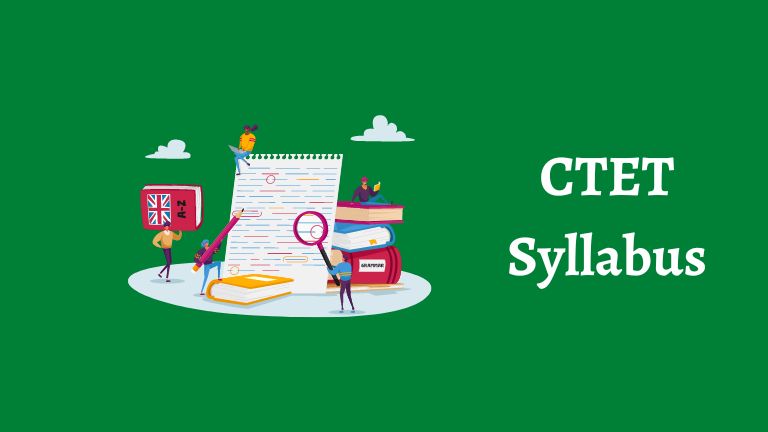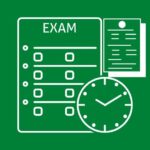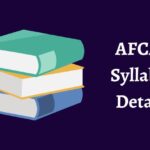CTET Syllabus: The eligibility test for the CTET Syllabus will be in two phases. Namely – Paper I and Paper II for the posts of teacher. Papers-I will test for candidates who aspire to become teachers for Class I to V. And Paper-II will carry for applicants who want to be teachers for Class VI to VIII. There is no change look out for CTET 2021 Exam Pattern & Syllabus. Also, the details of CTET syllabus are in the article.However, as mentioned in the official notification.
CTET Syllabus: Overview
Hence for the 1st time, the CTET 2021 exam will be in Online Mode from 16th December 2021 to 13th January 2022. So, the Central Teacher Eligibility Test is tested two times every year. Not only that, but we provide opportunities for candidates to make their career in the teaching sector through the Exam. To fetch a good score in the CTET Exam, you must follow the proper strategy. Also, preparation is a must. Knowledge of the syllabus is the initial step, to begin with, the practice. This article’s discussions describe the entire exam pattern and syllabus for the CTET 2021 December exam.
CTET Syllabus: Highlights
| Organisation | Central Board of Secondary Education (CBSE) |
| Name of Examination | CTET 2021 Exam |
| Duration of CTET Exam | 2.5 hours (for each paper) |
| Language of Exam | 20 languages |
| CTET 2021 Exam Date | December 2021/January 2022 |
| Maximum Marks | 150 marks (for each paper) |
| Category | CTET Syllabus & Exam Pattern |
| Type of Questions | Multiple Choice Questions |
| Mode of Exam | Online |
| Marking Scheme | 1 mark for each correct answer |
| Negative Marking | No negative marking for wrong answers |
CTET Exam Pattern
Looking out the CTET exam patterns helps make plans for studying, and candidates can see which topics they should focus on more.
- CTET will consist of two Parts: Paper-I for Class I-V. and Paper-II for Class VI-VIII.
- There ARE 150 MCQs for each paper.
- For both papers, there are no negative marks for each wrong answer.
- Not only that, for Paper-I is not tricky. But, the second stage is too difficult. For Paper-II, the difficulty level will be of the
- senior secondary stage.
- CTET Paper-1 has five sections: Child Development and Pedagogy, Language I & II, Mathematics, and Environmental Science.
- CTET Paper-2 has four sections: Child Development and Pedagogy, Language I & II, Mathematics/Science, or Social Studies.
- Choices will be available between Math/Science and Social Studies.
CTET Syllabus for Paper I Syllabus (For Classes I to V) Primary Stage:
| I. Child Development and Pedagogy |
| II. Language – I |
| III. Language – II |
| IV. Mathematics |
| V. Environmental Studies |
since, Paper- the exam for CTET will be an offline exam. So, it tests a candidate based on their Language I & II: child Development, Pedagogy, Also, Mathematics, and Environmental Studies. So, Let’s have a look at CTET Syllabus 2021 for the Primary Stage (Classes I-V ):
I. Child Development and Pedagogy Syllabus: 30 Questions
There are three sections. Fifteen questions come from the first section. Also, five questions come from the second section. And finally, ten questions come from the third section.So, let’s have a look
a) Child Development (Primary School Child): 15 Questions
- Concept of growth and its relationship with learning.
- Principles of the development of children
- The Influence of Heredity & Environment
- Socialization processes: Social world & children (Teacher, Parents, Peers)
- Piaget, Kohlberg, and Vygotsky: constructs and critical perspectives
- Concepts of child-centered and progressive education
- Critical perspective of the construct of Intelligence
- Multi-Dimensional Intelligence
- Language & Thought
- gender roles,
- Gender Roles, Gender as a social construct; gender-bias and educational practice
- Have a concept of Individual differences among learners. To understand differences based on language, caste, gender, community, religion, etc.
- The distinction between Assessment for learning and assessment of learning; School-Based Assessment, Continuous & Comprehensive Evaluation: perspective and practice
- We are formulating appropriate questions for assessing learners’ readiness levels, enhance learning and critical thinking in the classroom, and assess learner achievement.
b) Concept of Inclusive education and understanding of children with special needs: 5 Questions
- including disadvantaged and deprived, Addressing learners from diverse backgrounds,
- Addressing the needs of children with learning difficulties, ‘impairment,’ etc.
- Creative and Specially Enabled Learners, Addressing Talented.
c) Learning and Pedagogy: 10 Questions
- How and why children fail to succeed in school performance, how children think and learn.
- Have to learn the fundamental processes of teaching. Learning as a social activity; children’s learning strategies; the social context of education.
- Child as a problem solver and a ‘scientific investigator.’
- Another conception of learning to children understands children’s ‘errors’ as significant steps in the learning process.
- Cognition & Emotions
- Motivation and learning
- Factors contributing to learning – personal & environmental
II. Language I Syllabus: 30 Questions
Hence, there are two sections.1.Language Comprehension.And 2.Language Comprehension. therefore, 30 questions come from these two sections.so LETS CHECK,
a) Language Comprehension: 15 Questions
Unseen passages Reading –
- two passages
- one poem with questions on comprehension, AND
- one prose or drama,
- Grammar
- verbal ability (the prose passage may be scientific, literary, narrative, or discursive).
- Inference
b) Pedagogy of Language Development: 15 Questions
- Learning and acquisition
- Principles of language Teaching
- Challenges of teaching language in multiple classrooms; errors, language difficulties, and disorders
- Language Skills
- the function of language and how children use it as a tool,
- Role of listening and speaking;
- We are evaluating language comprehension and proficiency: reading and writing.
- speaking, listening,
- Teaching/learning materials: Pen, Digital Board, Textbook, multi-media materials, multilingual resources of the classroom
- Remedial Teaching
- A challenging perspective on the role of grammar in learning a language for communicating ideas verbally and in written form
III. Language II Syllabus: 30 Questions
a) Comprehension: 15 Questions
- Two unseen prose passages come with questions on comprehension
- Grammar and vocabulary
- verbal ability
b) Pedagogy of Language Development: 15 Questions
- Learning and acquisition
- Principles of language Teaching
- Challenges of teaching language in multiple classrooms; errors, language difficulties, and disorders
- Language Skills
- the function of language and how children use it as a tool,
- Role of listening and speaking;
- We are evaluating language comprehension and proficiency: reading and writing.
- speaking, listening,
- Teaching/learning materials: Pen, Digital Board, Textbook, multi-media materials, multilingual resources of the classroom
- Remedial Teaching
- A challenging perspective on the role of grammar in learning a language for communicating ideas verbally and in written form
IV. Mathematics Syllabus: 30 Questions
a) Content: 15 Questions
- Geometry
- Shapes & Spatial Understanding
- Solids around Us
- Numbers
- Addition and Subtraction
- Multiplication
- Division
- Measurement
- Weight
- Time
- Volume
- Data Handling
- Patterns
- Money
b) Pedagogical issues: 15 Questions
Firstly,Understand children’s thinking. And Secondly, find the reasoning patterns and strategies for making meaning and learning;Finally, Nature of Mathematics/Logical thinking;
- Place of Mathematics in Curriculum
- Language of Mathematics
- Community Mathematics
- Valuation through formal and informal methods
- Problems of Teaching
- Error analysis and related aspects of learning and teaching
- Diagnostic and Remedial Teaching
V. Environmental Studies Syllabus: 30 Questions
a) Content: 15 Questions
I. Family and Friends:
Relationships also, AnimalsPlants , Work and Play
II. Food
III. Shelter
IV. Water
V. Travel
VI. Things We Make and Do
b) Pedagogical Issues: 15 Questions
- Concept and scope of EVS
- Significance of EVS, integrated EVS
- Environmental Studies & Environmental Education
- Learning Principles
- Scope & relation to Science & Social Science
- Approaches to presenting concepts
- Activities
- Experimentation/Practical Work
- Discussion
- CCE
- Teaching Material/Aids
- Problems
CTET Syllabus 2022 for Paper II
Applicants preparing to appear for Paper-2 in CTET 2021 have to read the detailed syllabus for CTET Paper-II from the section below.
CTET Syllabus for Paper-II (For Classes VI to VIII) Elementary Stage:
- Child Development and Pedagogy
- Language – I
- Language – II
- Mathematics and Science
- Social Studies/Social Sciences
The Paper-II exam of CTET is an offline exam. Hence, this section tests a candidate based on their Language I & II. Child Development and Pedagogy, and Mathematics & Science / Social Studies & Social Science. Take a look at CTET Syllabus for Elementary Stage (Classes VI-VIII):
I. Child Development and Pedagogy Syllabus: 30 Questions
This topic is expected in Paper-1 and Paper-2, which is compulsory to be attempted. This section will cover the candidate’s knowledge about child development and the Concept of Inclusive education. Go through the topics below to understand the syllabus straightforwardly.
a) Child Development (Elementary School Child): 15 Questions
- Concept of growth and its relationship with learning.
- Principles of the development of children
- The Influence of Heredity & Environment
- Socialization processes: Social world & children (Teacher, Parents, Peers)
- Piaget, Kohlberg, and Vygotsky: constructs and critical perspectives
- Concepts of child-centered and progressive education
- Critical perspective of the construct of Intelligence
- Multi-Dimensional Intelligence
- Language & Thought
- gender roles,
- Gender Roles, Gender as a social construct; gender-bias and educational practice
- Have a concept of Individual differences among learners. To understand differences based on language, caste, gender, community, religion, etc.
- The distinction between Assessment for learning and assessment of learning; School-Based Assessment, Continuous & Comprehensive Evaluation: perspective and practice
- We are formulating appropriate questions for assessing learners’ readiness levels, enhance learning and critical thinking in the classroom, and assess learner achievement.
b) Concept of Inclusive education and understanding of children with special needs: 5 Questions
- including disadvantaged and deprived, Addressing learners from diverse backgrounds,
- Addressing the needs of children with learning difficulties, ‘impairment,’ etc.
- Creative and Specially Enabled Learners, Addressing Talented.
c) Learning and Pedagogy: 10 Questions
- How and why children fail to succeed in school performance, how children think and learn.
- Have to learn the fundamental processes of teaching. Learning as a social activity; children’s learning strategies; the social context of education.
- Child as a problem solver and a ‘scientific investigator.’
- Another conception of learning to children understands children’s ‘errors’ as significant steps in the learning process.
- Cognition & Emotions
- Motivation and learning
- Factors contributing to learning – personal & environmental
II. Language I Syllabus: 30 Questions
This section tests the applicants’ knowledge of the language. There will be 30 questions in CTET Paper-I and Paper-II.
a) Language Comprehension: 15 Questions
- Two unseen prose passages come with questions on comprehension
- Grammar and vocabulary
- verbal ability
b) Pedagogy of Language Development: 15 Questions
- Learning and acquisition
- Principles of language Teaching
- Challenges of teaching language in multiple classrooms; errors, language difficulties, and disorders
- Language Skills
- the function of language and how children use it as a tool,
- Role of listening and speaking;
- We are evaluating language comprehension and proficiency: reading and writing.
- speaking, listening,
- Teaching/learning materials: Pen, Digital Board, Textbook, multi-media materials, multilingual resources of the classroom
- Remedial Teaching
III. Language II Syllabus: 30 Questions
The second language test will be for accessing the candidate’s knowledge of the English language. There will be 30 questions in CTET Paper-I and Paper-II.
a) Comprehension: 15 Questions
Hence, two unseen prose passages come with questions on comprehension. Also, grammar and vocabulary, also,verbal ability.
b) Pedagogy of Language Development: 15 Questions
- Learning and acquisition
- Principles of language Teaching
- Challenges of teaching language in multiple classrooms; errors, language difficulties, and disorders
- Language Skills
- the function of language and how children use it as a tool,
- Role of listening and speaking;
- We are evaluating language comprehension and proficiency: reading and writing.
- speaking, listening,
- Teaching/learning materials: Pen, Digital Board, Textbook, multi-media materials, multilingual resources of the classroom
- Remedial Teaching
IV. (A) Mathematics and Science Syllabus: 60 Questions
SO, you can check the topics of the Mathematics and Science section.however, you should attempt the questions of Maths with tricks and accuracy. Moreover, there will be 30 questions from Math and 30 from Science subjects.
(i) Mathematics: 30 Questions
a) Content: 20 Questions
- Number System
- Know our Numbers
- Playing with Numbers
- Whole Numbers
- Negative Numbers and Integers
- Fractions
- Algebra
- Introduction to Algebra
- Ratio and Proportion
- Geometry
- Basic geometrical ideas (2-D)
- Understanding Elementary Shapes (2-D and 3-D)
- Symmetry: (reflection)
- Construction (using Straight edge Scale, protractor, compasses)
- Mensuration
- Data handling
b) Pedagogical issues: 10 Questions
- Nature of Mathematics/Logical thinking
- Place of Mathematics in Curriculum
- Language of Mathematics
- Community Mathematics
- Evaluation
- Remedial Teaching
- Problem of Teaching
(ii) Science: 30 Questions
a) Content: 20 Questions
Food: Sources of food, Components of food,Clean food.
II. Materials: daily use of material.
III. The World of the Living
IV. Moving Things People and Ideas
V. How things work: Electric current and circuits, Magnets
VI. Natural Phenomena
VII. Natural Resources
b) Pedagogical issues: 10 Questions
Nature & Structure of Sciences
- • Natural Science/Aims & objectives
- Understanding & Appreciating Science
- Approaches/Integrated Approaches
- Observation/Experiment/Discovery (Method of Science)
- Innovation/Evaluation – cognitive/psychomotor/affective
- Text Material/Aids
- Problems
- Remedial Teaching
V. Social Studies/Social Sciences Syllabus: 60 Questions
Therefore, the topics are divided into two parts. One includes History, Geography, Social & Political Life, and the second one has Pedagogical issues.
History
Therefore, this section will have a strong catch on historical events, days, and dates to score BETTER marks. Questions COMES from the below topics. So, let’s see-
- When, Where and How
- The Earliest Societies
- The First Farmers and Herders
- The First Cities
- Early States
- New Ideas
- The First Empire
- Contacts with Distant lands
- Political Developments
- Culture and Science
- New Kings and Kingdoms
- Sultans of Delhi
- Architecture
- Creation of an Empire
- Social Change
- Regional Cultures
- Establishment of Company Power
- Rural Life and Society
- Colonialism and Tribal Societies
- The Revolt of 1857-58
- Women and reform
- Challenging the Caste System
- The Nationalist Movement
- India After Independence
II. Geography
It is difficult for candidates to understand the entire geography of India unless they go deep into it; CBSE has included a geography subject for CTET Paper-II. Still, no worries, you only have to prepare for a few topics that have been provided below.
- Geography as a social study and as a science
- Planet: Earth in the solar system
- Globe
- Environment in its totality: natural and human environment
- Air
- Water
- Human Environment: settlement, transport and communication
- Resources: Types-Natural and Human
- Agriculture
III. Social and Political Life
Hence, this section will test the applicant’s knowledge about their surroundings, and the topics that a candidate must be knowledgeable about have been listed below.So, lets have a look
- Diversity
- Government
- Local Government
- Making a Living
- Democracy
- State Government
- Understanding Media
- Unpacking Gender
- The Constitution
- Parliamentary Government
- The Judiciary
- Social Justice and the Marginalised
b) Pedagogical issues
Hence, there will be 20 questions from this section and the motive of this section.
- Concept & Nature of Social Science/Social Studies
- Classroom Processes, activities and discourse
- Developing Critical thinking
- Enquiry/Empirical Evidence
- Problems teaching Social Science/Social Studies
- Sources – Primary & Secondary
- Projects Work
- Evaluation
| Read Also: SSC CGL Syllabus 2021 and Exam Pattern with pdf |
Frequently Asked Questions On CTET Syllabus
#1. What is the exam mode of CTET?
Ans: Hence, the exam will be held in Online mode.
#2.For the CTET Exam, are there any negative markings?
Ans: In conclusion, there is no negative marking.



